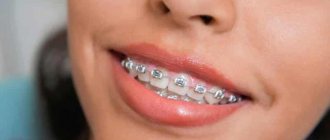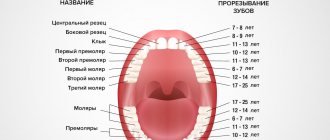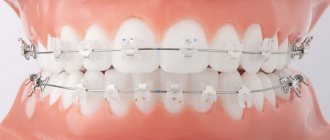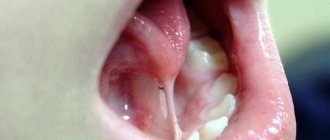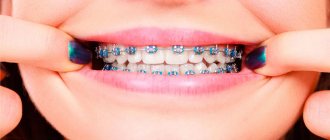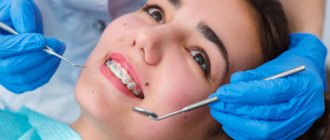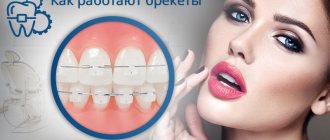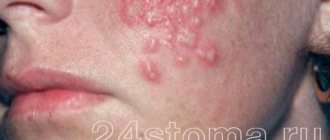The bracket system is a non-removable structure used in orthodontic practice to correct the patient’s bite. Special non-removable plates are attached to the outer or inner surface of the teeth throughout the entire dentition. Each bracket has a groove in which the orthodontic arch is attached. The use of braces is often necessary for the normal functioning of the human maxillofacial apparatus. The main indication for the installation of this design is an incorrect bite, as well as a single incorrect location or absence of one or more teeth.
Attention! The use of orthodontic plates allows not only to correct the bite, but also to prevent the development of other pathologies: gastrointestinal diseases, destruction of the jaw joints, damage to the tissues of the tongue and cheeks, etc.
Until what age can you get braces?
Why do you need to get braces?
Uneven teeth complicate the processes of communication and socialization, as they look unsightly. They form many complexes. Bite defects and uneven dentition cause poor dental health (caries, periodontitis, wedge-shaped defects), problems with the gastrointestinal tract due to disruption of the process of chewing food. Bite pathology is associated with the appearance of health problems that have nothing to do with the digestive process.
It can be:
- pathology of the temporomandibular joint;
- the appearance of severe headaches;
- diseases of the ENT organs;
- poor posture.
Deformation of the facial skeleton and respiratory diseases are detected.
Is it possible to straighten teeth without braces?
Any orthodontist knows well that parents who bring their heirs to an appointment always insist on installing braces, knowing full well how important the image role of a perfect smile is in our society. When it comes to straightening their own teeth, many try to limit themselves solely to masking existing anomalies with the help of ceramic veneers or lumineers. This is one of the significant features of adult patients.
But the laws of orthodontics do not depend on a person’s age. Therefore, neither an abnormal bite nor crowded teeth can be corrected by aesthetic dentistry. “Just straightening up your front teeth,” as an elegant lady aged 35+ wants, will not work if the reason for their protruding forward is a pathological bite. Whether you like it or not, you will have to wear braces.
What types of structures are there?
There are different types of bracket systems according to their design features and method of attachment to surfaces.
Systems come in the following types:
- Vestibular – orthodontic structures attached to the front surface of the teeth. This is a more affordable option in terms of cost.
- Lingual – systems for correcting malocclusions that are glued to the inner surface of the tooth.
Orthodontic structures are made from various materials. For these products the following are used: metal with shape memory, plastics, ceramics, artificial sapphires, gold. Based on design features, they are divided into: self-regulating systems and ligature ones.
Difference between vestibular braces and systems based on material:
Metal braces
The most common and popular type of inexpensive systems. They are classics of orthodontics and have been used for several decades. Made from hypoallergenic steel and metal alloys. In various proportions it includes: gold, silver, zirconium. They are characterized by high wear resistance. No cases of structural failure were recorded.
Advantages:
- shorter period of wearing due to increased impact on teeth;
- ease of care.
Flaws:
- lack of aesthetic effect;
- discomfort of the adaptation period.
The comfort of wearing depends on the presence of the ligature.
Ceramic braces
Despite the fact that the system is attached from the front side, it is almost invisible due to its matte shade, which blends with the color of the teeth.
Made from mono- or polycrystalline.
Design advantages:
- aesthetic appearance - only the metal arc is visible;
- comfortable to wear.
Minuses:
- significantly more expensive than a metal system;
- fragility (the wearing period increases due to the difficulty of exerting stronger pressure on the crowns);
- if it breaks down it cannot be repaired, a new design is made;
- They are more difficult to remove than metal ones.
Ceramic braces are rarely used due to impracticality. They are most often used in combined systems on molars and premolars.
Sapphire braces
Despite their high cost, sapphire designs are popular. They not only have a healing effect, but also decorate the teeth.
Made from artificial sapphire - monocrystalline type. In twilight light they are practically invisible on the teeth, but in the sun they shimmer with all the colors of the rainbow, like a piece of jewelry.
This is what attracts teenagers.
This type of system is manufactured in two versions:
- with a transparent arc;
- metal arc.
A design with a metal arc costs an order of magnitude less.
There are also plastic systems. They are used rarely and mainly for young children who have a minor defect or require minor correction.
Mechanism of action
Correction by this method is based on the ability of teeth to shift under mechanical influence from the outside. They are fixed in the jaw in a movable manner. Systems allow units to be corrected to be offset. This happens by pulling them out of the alveolar process, or vice versa, by deep immersion into the socket. It allows you to rotate them around their axis or tilt them in the required direction. With prolonged exposure, the bone of the alveolar process is resorbed, freeing up space for displacement. On the opposite side, where the dental ligament is stretched, bone tissue grows and the tooth is fixed in the required position.
Problems with teeth and gums are a feature of adult orthodontic patients
Is it possible to put braces on crowns and filled teeth? This question is extremely relevant for adults who have decided to undergo orthodontic treatment, because the condition of their teeth, and sometimes gums, very often leaves much to be desired. The process is often complicated by the presence of a large number of fillings placed long ago, pulpless teeth covered with crowns, and sometimes problems with periodontium. Therefore, a patient who comes for an appointment at the orthodontic center for the first time is prescribed a thorough diagnosis, and based on its results, a consultation with specialized specialists: a therapist, a periodontist, a surgeon.
- Ultimately, only the doctor decides whether to put braces on fillings. It all depends on the condition of the tooth enamel, the quality and service life of the filling. If necessary, the tooth is resealed to prevent the “historic” dental cement from cracking or splitting.
- The problem with crowns is also solved individually. Teeth covered with them can only be moved if their roots are not damaged. If the crown is part of a bridge, the bridge will have to be sawed to release it, or it will have to be removed and a temporary plastic prosthesis made for the patient. Since the surface of the crowns is smoother than tooth enamel, it is best for the patient to install metal braces in installments, which have a more reliable fixation.
What is the installation
Installing braces is a difficult and lengthy process. A thorough examination is carried out before it.
The installation includes the following stages:
- The oral cavity is thoroughly prepared (treatment of all inflammatory processes in the oral cavity, carious teeth, professional cleaning);
- taking impressions of the jaws, making all the necessary calculations;
- manufacturing, individual adjustment of the system to the jaw, teeth;
- installation of an orthodontic system;
- patient adaptation to braces.
On average, any malocclusion pathology can be resolved with fixed orthodontic structures in up to two years.
Cost of braces for children
The final price for correcting a child’s bite in St. Petersburg varies depending on the complexity of the deformity, the type of system installed, the number of additional services, the timing of the correction, and the clinic’s pricing policy.
| Name | Minimum cost |
| Taking an impression | 600 |
| Comprehensive diagnostics | 2500 |
| Damon-Q bracket system (1 jaw) | 27000 |
| Damon Clear bracket system (1 jaw) | 35000 |
| Partial bracket system | 20000 |
| Removal (1 jaw) | 3000 |
| Retainer installation | 6000 |
| Activation | 1850 |
Indications
When it is possible to put braces on a child, how can parents understand that he needs to correct the pathology of occlusion. Incorrect development of teeth and jaws becomes noticeable even in primary occlusion.
Signs to suspect that correction may be required:
- one or both parents have malocclusions;
- long-term disruption of nasal breathing;
- there are habits that can deform the dentition (finger sucking, foreign objects, prolonged pacifier sucking);
- visible dentition disorders;
- disproportionate development of the jaws;
- the child has diabetes and diseases of the nervous system.
In these cases, parents should take the student to an orthodontist for an examination. This is necessary to resolve questions about the advisability of correcting dental anomalies, installing braces for their children, and determining at what age it is best to start treatment.
What is malocclusion and why does it occur?
A person has two jaws - upper and lower. The closure of the teeth of the two jaws is called a bite. If this closure is even, the bite is considered correct; if the teeth of one row, when closing, overlap the teeth of the second row, they speak of an incorrect bite. Orthodontists treat such dental disorders. Malocclusion often develops in childhood and can be due to various reasons.
- Difficult pregnancy and childbirth.
One of the common causes is birth trauma, which results in pathologies of the neurological system and musculoskeletal system. These disorders lead to improper development of the jaws.
- Mistakes when breastfeeding.
In a baby, the upper jaw is larger than the lower jaw. When a baby nurses, the jaw muscles naturally tighten and alignment occurs. If the baby is not breastfed or eats incorrectly, the formation of a correct bite may be disrupted.
- Poor posture, problems with the musculoskeletal system.
If a child often slouches, not only the spine is deformed, but also the position of the jaw.
- Lack of teeth.
If for some reason a tooth falls out or is removed ahead of schedule, other teeth tend to take up the vacant space, the habit of gnawing hard objects appears, and the tone of the masticatory muscles is impaired.
Also, the cause of malocclusion may be a short frenulum of the tongue, a lack of vitamins and minerals in the diet. The bite is formed incorrectly in those children who often suffer from acute respiratory viral infections and in whom normal nasal breathing is disrupted. They are forced to keep their mouth slightly open, which leads to abnormal bite development.
At what age is it established
There are different opinions among orthodontists about the age at which children can wear braces. Some believe that they can be installed from the age of seven. You just need to use special systems. Others believe that it is advisable to install them only in adolescence (over twelve years).
Before installation before adolescence, the following must be considered:
- It is advisable to install correction systems only after the eruption of the second molars, since there is a risk of teeth erupting in the wrong place;
- Mandatory examinations must be carried out to exclude severe defects in the development of the jaws, imbalances in the development of the facial skeleton and muscles;
- the length of the teeth must be sufficient to install locking fasteners;
- the enamel layer must be well developed, capable of withstanding the fastening of the system;
- It is necessary to find out how the load on the teeth occurs so that it does not become excessive when installing the system.
In a child of primary school age, structures are installed only according to strict indications. When delay leads to the development of defects that cannot be corrected if the structures are installed later. His general physical condition must be taken into account. Until the age of twelve, it is better to correct the bite using removable plates.
When should correction begin?
Elimination of occlusal defects in a child can and should begin with the eruption of baby teeth. Bone tissue in babies has not yet formed, so it is easily susceptible to any external influence. But during this period, braces are not used.
Let's consider when and how to correct the bite of children and adolescents:
- at 2-3 years, if necessary, treatment is carried out using special exercises for the facial muscles;
- at 5 years of age and older, removable orthodontic structures can be used for corrective therapy: trainers, plates and aligners;
- From 12-14 years old you can use braces. Their installation in children under 12 can only be performed for special medical reasons.
Not only age is the determining point in starting correctional therapy, but also the cumulative fulfillment of the following conditions:
- the completed process of tooth growth;
- the height of the coronal part is sufficient for fixing the bracket plates;
- strong enamel.
In any case, the possibility of installing a brace system is decided by the orthodontist in each specific situation after a visual and hardware examination.
What problems may arise
Children are not able to maintain oral hygiene to the required extent. They do not take care of them, the structures may not last long, they break and the locks come unglued.
Other possible problems:
- Until the age of thirteen, children have soft and thin enamel. It is easily damaged when installing and wearing braces.
- The roots of the teeth are not yet strong. If the orthodontic structure is placed early, the roots may be destroyed and they will fall out.
- If correction systems are installed early, the teeth will become straight, but after they are removed as the jaw grows, curvature and discrepancy may occur again.
The question of at what age children get braces should be considered individually. Only an orthodontist can determine the age at which it is optimal for a child to have fixed structures installed based on individual indications and contraindications.
Maximum age limit
The formed bone tissue of an adult is difficult to mechanically influence, so the corrective process takes longer than in children. Often you even have to remove one element to make room for the rest to move.
No doctor will tell you the exact age after which braces cannot be installed. The possibility of correcting pathologies using brace systems is determined individually depending on the following factors:
- anatomical features of the dentofacial apparatus;
- condition of bone tissue;
- health of the body as a whole.
Is it possible to get braces if you have periodontitis?
Periodontitis, inflammatory gum disease, and malocclusion are two sides of the same coin.
- A malocclusion is often characterized by crowded teeth. At the same time, their high-quality cleaning from food debris and plaque is significantly difficult, and the likelihood of the formation of tartar, the main cause of periodontitis, is increased. Without eliminating the dental anomaly, it is impossible to cure inflammation of periodontal tissues.
- Of course, in the acute stage of the disease, orthodontic treatment cannot be carried out. The patient will first be prescribed professional teeth cleaning and therapeutic treatment, and only after that will the braces be installed.
Straightening teeth with braces for periodontitis has a number of distinctive features. In particular, the traction force of the orthodontic arch will be reduced, therefore, the treatment period will increase. You will also have to wear retainers longer than usual. In addition, the patient must especially carefully perform hygiene procedures. Only if these conditions are met, bite correction will play a positive role and stop the progression of periodontitis.
Unfortunately, significant degenerative processes in the periodontium, in particular, strong resorption of bone interradicular septa, can become a contraindication to bite correction with braces.
Indirect restrictions
To correct your bite, it is important that your teeth are strong and your gums are healthy. The body must be able to withstand prolonged additional stress in the form of wearing braces or other devices. Over time, the patient has more and more contraindications: for example, the risks of developing diabetes and other ailments increase, complicating the process or negatively affecting the final result. With prolonged smoking, the enamel and tissues of the oral cavity are greatly weakened, which is why wearing braces can become a serious problem. As a result, everything largely depends not so much on age, but on the state of the body at these years, how ready it is for various interventions.
Features of installation and care
Before installing braces on a child, the orthodontist examines and examines the oral cavity, and sends the little patient for x-rays and other examinations. After this, the specialist can begin sanitation, that is, eliminating foci of inflammation, caries, strengthening enamel, etc. This is necessary because food particles can easily get stuck in and under braces, which can only make the situation worse in the future.
After this, the doctor can begin taking impressions of the patient’s jaw, on the basis of which the braces will be made. To do this, the impressions are sent to a dental laboratory. The finished structures are fixed on the enamel surface using special glue, and a metal arc is inserted into the hole in the locks.
Immediately after installing braces, you may experience minor discomfort and a lisp, but this goes away very quickly.
It is important to understand that installing braces in childhood requires maximum responsibility not only from the child, but also from his parents. They need to carefully monitor their child’s regular oral hygiene and, if they detect the slightest deviation from the norm, immediately consult an orthodontist.
previous post
How long do adults wear braces?
next entry
Moving to another city is another difficulty in orthodontic treatment for adults
In the photo before and after braces, even a non-specialist can clearly see how the position of the teeth and the nature of the bite improve during the process of orthodontic treatment. But, unfortunately, the result of the correction sometimes leaves much to be desired, and this is not always due to the lack of qualifications of the dentist. In the case of older patients, problems often arise due to their frivolous attitude towards the extremely complex process of teeth straightening.
If the situation is such that a person moves to another city for family or work reasons, therapy is usually interrupted for an indefinite period, so the achieved result is quickly lost and the teeth move in different directions.
Suitable age for the child
Children are allowed to have orthodontic appliances installed from the age of 8-9, when baby teeth begin to be replaced by permanent ones. However, at this age there is no point in using braces; treatment with special aligners or a plate will suffice. The peculiarity of this treatment is that the aligners and plates can be changed as the child and his jaw grow, and expensive braces would have to be reinstalled.
Orthodontic treatment at an early age can be prescribed only in the most extreme cases, in the presence of very serious pathologies or the risk of their development in the future. As you know, at an older age, it is much more difficult to correct malocclusions and it takes longer.
Braces themselves are allowed to be installed from 11-12 years old. The main indications for installation: severe asymmetry of the jaw and disturbance in appearance, serious bite pathologies and, as a result, regular injury to the inner surface of the cheeks and tongue. The child may also have problems with diction and breathing, impaired swallowing function, and much more.

